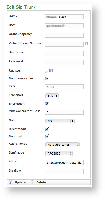figure 1. "Edit Sip Trunk" form
In figure 1. "Edit Sip Trunk" form you can see an example configuration for creating a SECURE Inbound SIP Trunk. The mandatory values are:
- NAME: a meaningful name for this trunk
- HOST: IP address/hostname of the SIP server provided by ITSP
- PORT: this is 5061 by RFC
- TRANSPORT: pro
- DIRECTMEDIA: check it enabled
- SENDRPID: check it enabled
The default values for Port, Allow and Disallow are usually work well, however feel free to change them to suite your needs better.
Optional fields are:
- CONCURRENT CALLS: you can leave the default, which is often a practice value for the day-by-day service and change it later if you notice call drops on this Trunk.
- NAT: check this box if you are not using directly the public IP address.
- AUDIO TONES: ON EARLY MEDIA works fine with the Cisco Unity Call Manager. Avaya instead can deal with both N EARLY MEDIA and ON ANSWERED CALL.
- DTMFMODE: choose your values considering the PBX on the other end of the Trunk. Usually we suggest to choose the value RFC2833
- ALLOW: the values of this fields highly depends from what the other end is capable of. Our suggestion is to leave the default: g729,amr,gsm,ulaw,alaw
- DISALLOW: the values of this fields highly depends from what the other end is capable of. Our suggestion is to leave this field empty.
